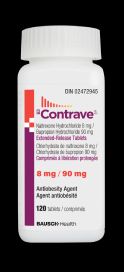
Mechanism of Action1*
Non-clinical studies suggest CONTRAVE has effects on two separate areas of the brain involved in the regulation of food intake:
- The hypothalamus with its appetite regulatory center
- The mesolimbic dopamine circuit with its reward system
The exact neurochemical effects of CONTRAVE leading to weight loss are not fully understood.
CONTRAVE is made of two components:1

Naltrexone is an opioid antagonist and buproprion is a relatively weak inhibitor of the neuronal reuptake of dopamine and norepinephrine. Naltrexone and bupropion are thought to have effects in areas of the brain involved in the regulation of appetite and reward systems:
Hypothalamus (appetite regulatory centre)
Mesolimbic dopamine circuit (reward centre)
Adapted from the product monograph.1
Pharmacodynamics1*
Combined, bupropion and naltrexone:
Increased the firing rate of hypothalamic POMC neurons in vitro. POMC are associated with regulation of appetite.
Reduced food intake when injected directly into the VTA of the mesolimbic circuit in mice. VTA is associated with regulation of reward pathways and cravings.
References:
- CONTRAVE Product Monograph. Bausch Health Canada, March 2, 2022.


Find out about ExperienceContrave.ca — one single gateway for easy patient self-enrollment!
Phase 3 studies assessed weight change in patients with and without diabetes, weight change in conjunction with intensive BMOD counselling, as well as CV and metabolic parameters. Have you seen all of the clinical data?
POMC: pro-opiomelanocortin; VTA: ventral tegmental area.
*Clinical significance unknown.
